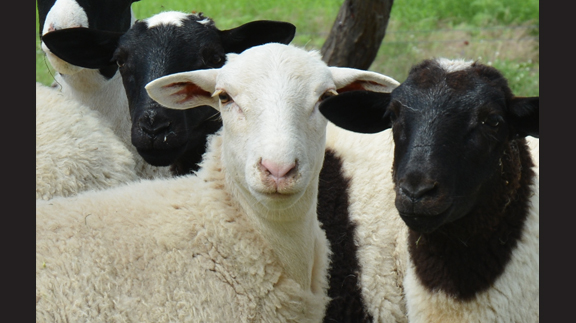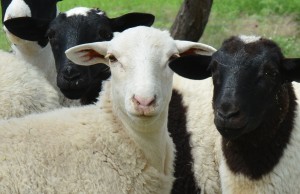Farm & Ranch
Expert: White wooly sheep don’t reflect today’s sheep industry

By: Steve Byrns
Hair sheep surpass wool sheep in historical wool producing region
Writer: Steve Byrns, 325-653-4576, [email protected]
Contact: Bill Thompson, 325-653-4576, [email protected]
SAN ANGELO – The hair sheep industry has grown considerably since the mid-1990s when U.S. sheep producers first started to take notice of the meat producing breeds, said an agricultural economist at San Angelo.
Bill Thompson, with the Texas A&M AgriLife Extension Service, said he and Dr. Dan Waldron, Texas A&M AgriLife Research geneticist at San Angelo, recently secured data from Producers Livestock Auction Company to determine the sheep industry’s current market trends.
Thompson said the San Angelo auction reportedly remains the largest sheep and goat market in the U.S.. He said San Angelo, long known as the nation’s Wool Capital, has seen a turn of events in recent years.
“Looking at those numbers, they’ve sold more hair sheep through that auction since 2011 than they have wool lambs, so the market has changed considerably over the last several years,” Thompson said.
He also said their study only dealt with animals sold through the ring and did not take into consideration those animals sold straight off the range through an order buyer. Those sales, he said, are generally large offerings of strictly wool sheep.
He said there has been a steady downward trend in wool sheep numbers for years for a variety of reasons including predation, lack of shearers, general labor and sluggish markets to name a few.
He pointed to the drought and subsequent wildfires across West Texas in 2011 as factors that sped up the loss of wool sheep numbers. He said the combination of drought and fire across prime sheep range forced a large number of operations to greatly reduce their flocks and a smaller number of producers to liquidate their flocks altogether. A percentage of those returning appear to have restocked with hair sheep.
“We get asked a lot what the differences are between hair lamb prices and wool lamb prices and we specifically went to the sale barn for data so we could analyze those differences,” Thompson said. “We found some interesting things.”
One point of particular interest was lot size or the number of animals sold at a given time.
“Wool lamb producers will be compensated for putting together larger lots of uniform lambs,” Thompson said. “The bigger the lot size, the higher the price they get for them. We don’t see that same advantage for the hair sheep. I think their market is segmented enough that those buyers can’t necessarily buy large lots because they are actually filling very specific orders on their direct slaughter market.”
Thompson said as is the case with most livestock, most of the time, lighter animals bring more dollars per pound, but heavier animals typically bring more dollars per head.
“For any livestock, that’s typically the case,” he said. “What we saw in the hair sheep though is as the animals get bigger, that discount relative to wool sheep actually increases. So that tells us a couple things.
“On a 70-100 pound wool lamb, there are actually two separate markets bidding for those lambs. They can just as easily go to a terminal or slaughter market somewhere or they are capable of being fed to even greater weights as they do well in a feedlot. Because they’ve also got order buyers bidding on them to put them in a feedlot, there’s more competition. They seem to get a considerably better price than the same 70-100 pound hair lamb would, which is just basically being bid on by people buying for the direct slaughter market.”
Thompson said hair sheep tend to become too fat to make feeding them for any length of time profitable in today’s markets.
He said there are basically two segments of the lamb-consuming–public. Some eat very little lamb and others eat quite a bit of lamb on a regular basis. Nationally, the per capita consumption of lamb is right around a half pound per person per year.
“But again,” he said, “the people that do eat lamb, eat quite a bit of it and that’s largely the ethnic markets, certainly on both coasts. But we’re now seeing more developing markets in the interior as well.”
Thompson said the growth in the hair sheep industry stems largely from their ease of care. He said many who become interested in the hair sheep breeds, do so because they do not require shearing, are hardy, often have multiple births and if properly managed, can quickly turn a profit. And unlike wool sheep, which are highly seasonal breeders, hair sheep can lamb year around.
“As far as price per pound, both wool and hair sheep bring the best price per pound at that 50-55 pound range,” Thompson said. “But again, as they get heavier, the price falls off quite a bit quicker for the hair sheep than for the wool sheep. There seems to be a market preference for the lighter hair sheep relative to the wool lambs.
“Both the hair and wool sheep lambs display that seasonal pattern where we see the sharp drop-off in price in June, July and August due to the seasonality of our breeding system whereby we are bringing most of our lambs to town to market. We oversupply the market in that pretty narrow window and prices decrease as a result.
“We may have a little more flexibility, a little less seasonality in the breeding of the hair sheep so we might be able to adjust our breeding season to lamb them a little bit earlier, thus wean them a little bit earlier and get them marketed before that price really falls off. Or push our breeding season forward so we can maybe market them a little bit later after the market picks back up.”
-30-
Find more stories, photos, videos and audio at http://today.agrilife.org
Farm & Ranch
Hazards of Backyard Poultry

By Barry Whitworth, DVM
Having backyard poultry is a popular agriculture enterprise. According to the United States Department of Agriculture, 0.8 percent of all households in the United States have chickens. People keep chickens for a variety of reasons with table eggs being one of the more common reasons.
Unfortunately, some of these poultry producers are not aware of the hazards that come with keeping poultry because many times they carry pathogens but appear healthy.
Chickens are carriers of several zoonotic diseases. These are diseases that can be passed from animals to humans. According to a recent survey in Pennsylvania, a majority of backyard poultry producers were aware of the dangers of avian influenza. However, this study also revealed that far fewer producers were aware of the risk of possible exposure to Salmonella and Campylobacter.
The lack of knowledge about the hazards of raising poultry likely contributes to the continued issues of Salmonella outbreaks associated with backyard poultry. In 2023, the Centers for Disease Control and Prevention reported 1,072 illnesses of Salmonella linked to backyard poultry, and 272 of those patients required hospitalization. Oklahoma reported 43 individuals with the disease.
To read more, pick up a copy of the April issue of NTFR magazine. To subscribe by mail, call 940-872-5922.
Farm & Ranch
Ag Elsewhere: Wyoming

By Tressa Lawrence
Babies are tucked away in every nook and cranny. Many ranchers across Wyoming have baby animals popping up all over this time of year.
Farm & Ranch
Ag Elsewhere: Montana

By Lindsey Monk
Another load of grain in to keep feeding the calves until the green grass can really start popping.
-

 Country Lifestyles1 year ago
Country Lifestyles1 year agoScott & Stacey Schumacher: A Growth Mindset
-

 Equine7 months ago
Equine7 months agoThe Will to Win
-

 Country Lifestyles7 years ago
Country Lifestyles7 years agoStyle Your Profile – What your style cowboy hat says about you and new trends in 2017
-

 Country Lifestyles4 years ago
Country Lifestyles4 years agoAmber Crawford, Breakaway Roper
-

 HOME7 years ago
HOME7 years agoGrazing North Texas – Wilman Lovegrass
-

 Country Lifestyles7 years ago
Country Lifestyles7 years agoDecember 2016 Profile, Rusty Riddle – The Riddle Way
-

 Country Lifestyles8 years ago
Country Lifestyles8 years agoJune 2016 Profile – The man behind the mic: Bob Tallman
-

 Outdoor9 years ago
Outdoor9 years agoButtercup or Primrose?







